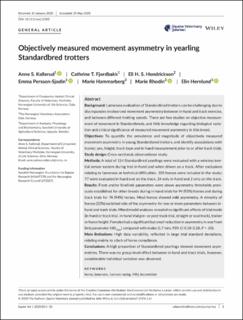| dc.contributor.author | Kallerud, Anne Selven | |
| dc.contributor.author | Fjordbakk, Cathrine | |
| dc.contributor.author | Hendrickson, Eli Helene Støkken | |
| dc.contributor.author | Persson-Sjodin, Emma | |
| dc.contributor.author | Hammarberg, Marie | |
| dc.contributor.author | Rhodin, Marie | |
| dc.contributor.author | Hernlund, Elin | |
| dc.date.accessioned | 2021-03-23T09:50:10Z | |
| dc.date.available | 2021-03-23T09:50:10Z | |
| dc.date.created | 2021-01-17T16:18:41Z | |
| dc.date.issued | 2020 | |
| dc.identifier.citation | Equine Veterinary Journal. 2020, 1-10. | en_US |
| dc.identifier.issn | 0425-1644 | |
| dc.identifier.uri | https://hdl.handle.net/11250/2735007 | |
| dc.description.abstract | Background
Lameness evaluation of Standardbred trotters can be challenging due to discrepancies in observed movement asymmetry between in‐hand and track exercise, and between different trotting speeds. There are few studies on objective measurement of movement in Standardbreds, and little knowledge regarding biological variation and clinical significance of measured movement asymmetry in this breed.
Objectives
To quantify the prevalence and magnitude of objectively measured movement asymmetry in young Standardbred trotters, and identify associations with trainer, sex, height, track type and in‐hand measurement prior to or after track trials.
Methods
A total of 114 Standardbred yearlings were evaluated with a wireless inertial sensor system during trot in‐hand and when driven on a track. After exclusions relating to lameness or technical difficulties, 103 horses were included in the study; 77 were evaluated in‐hand and on the track, 24 only in‐hand and 2 only on the track.
Results
Front and/or hindlimb parameters were above asymmetry thresholds previously established for other breeds during in‐hand trials for 94 (93%) horses and during track trials for 74 (94%) horses. Most horses showed mild asymmetry. A minority of horses (20%) switched side of the asymmetry for one or more parameters between in‐hand and track trials. Mixed model analyses revealed no significant effects of trial mode (in‐hand or track trial, in‐hand trial pre‐ or post‐track trial, straight or oval track), trainer or horse height. Females had a significant but small reduction in asymmetry in one front limb parameter (HDmax) compared with males (1.7 mm, 95% CI 0.18‐3.28, P = .03).
Conclusions
A high proportion of Standardbred yearlings showed movement asymmetries. There was no group‐level effect between in‐hand and track trials, however, considerable individual variation was observed. | en_US |
| dc.language.iso | eng | en_US |
| dc.rights | Attribution-NonCommercial-NoDerivatives 4.0 Internasjonal | * |
| dc.rights.uri | http://creativecommons.org/licenses/by-nc-nd/4.0/deed.no | * |
| dc.title | Objectively measured movement asymmetry in yearling Standardbred trotters | en_US |
| dc.type | Peer reviewed | en_US |
| dc.type | Journal article | en_US |
| dc.description.version | publishedVersion | en_US |
| dc.source.pagenumber | 1-10 | en_US |
| dc.source.journal | Equine Veterinary Journal | en_US |
| dc.identifier.doi | 10.1111/evj.13302 | |
| dc.identifier.cristin | 1872664 | |
| dc.relation.project | Norges forskningsråd: 272327 | en_US |
| cristin.ispublished | true | |
| cristin.fulltext | original | |
| cristin.fulltext | original | |
| cristin.qualitycode | 2 | |

